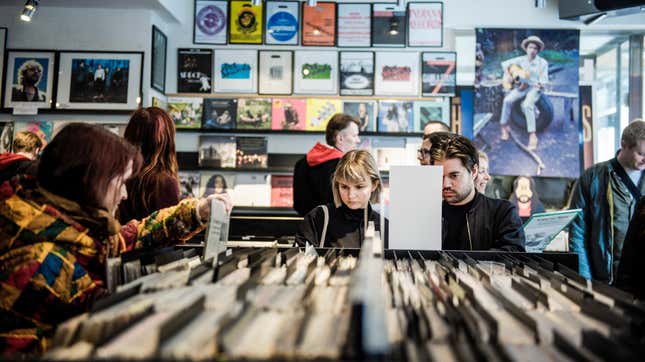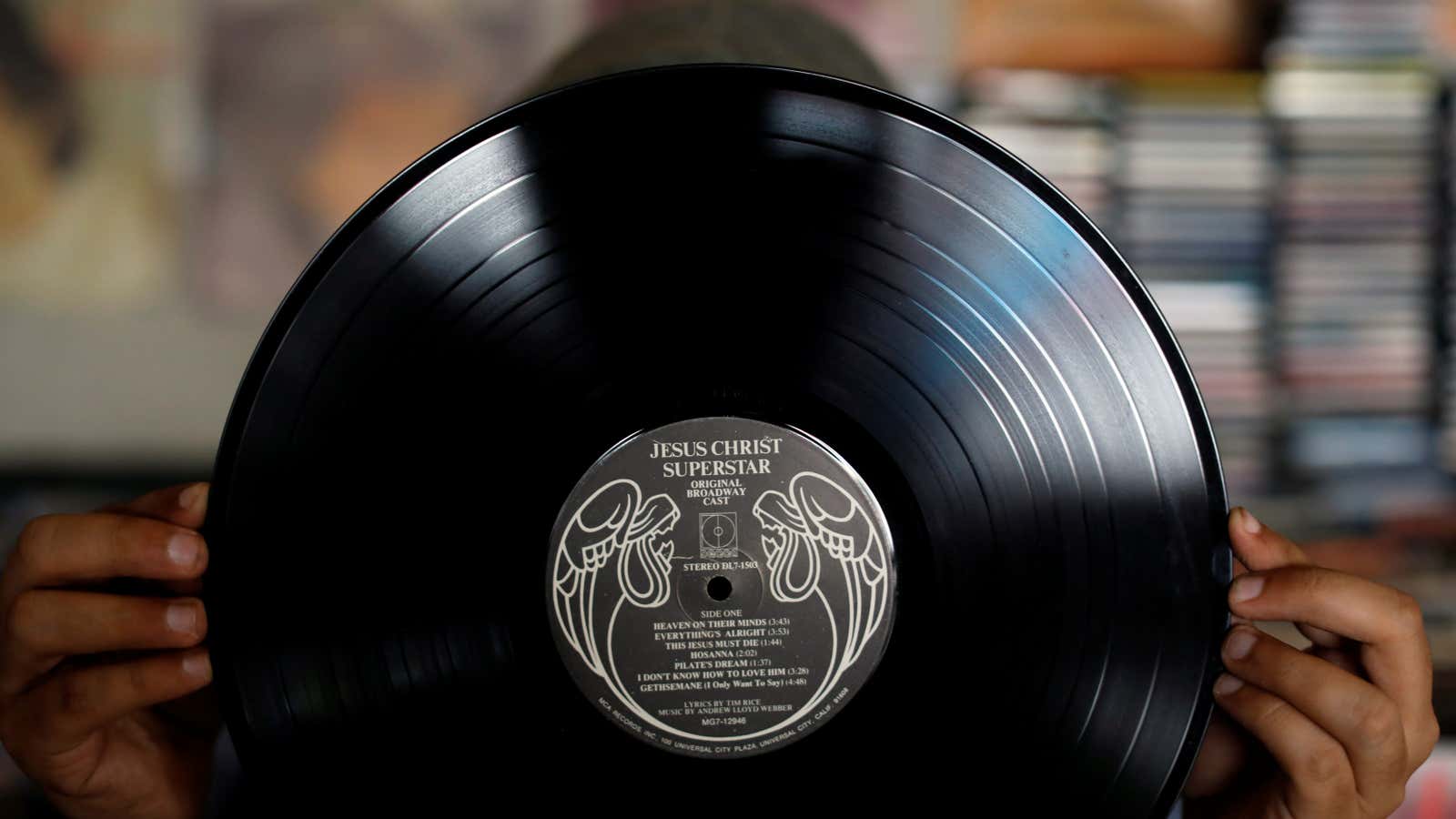It’s not often that a 19th century old technology makes a comeback. But that’s exactly what has happened to the phonograph record. After more than a decade of increasing sales, and the boom continuing through a pandemic, it’s safe to say it: Vinyl is back, baby.
At the start of the Covid-19 pandemic, it wasn’t so clear the record industry would continue to thrive. As a physical good with a complicated manufacturing process, it seemed to be under more threat than streaming, the predominant way people now listen to music.
“The biggest issue [in the vinyl industry] is the broken supply chain,” said the Vinyl Alliance, a trade industry group in April 2020. Increasing shipping costs, a lack of live concerts at which to sell merchandise, and a slow down in new vinyl requests from musicians had record production and sales declining.
But the demand for vinyl records was too strong to keep the industry down. Manufacturing quickly got back to normal, and, in the US, 2020 unit sales are up over 17% from 2019. The appeal of the record, with its tangibility, beauty and history, just keeps on growing.
No broken record
The American inventor Thomas Edison unleashed the phonograph on to world in the late 1870s. It revolutionized humans relationship with sound.
From his work developing the telephone and telegraph, Edison realized he could capture sound through horns and then inscribe the vibrations from that sound on to a material. That process could then be reversed when people wanted to hear what was recorded. The material used for inscription needed to be pliable enough to be impressed upon, but sturdy enough not to change afterwards (early phonographs used wax). Edison’s phonographs were cylinders, but soon after they would be made as discs which look similar to today’s records.
The phonograph record was the first reliable technology for recording and playing back audio. “Before recorded music became ubiquitous, music was, for most people, something we did,” writes former Talking Heads frontman David Byrne in his 2012 book How Music Works. “Many people had pianos in their homes, sang at religious services, or experienced music as part of a lived audience.” Pessimists argued that it would change people’s relationship with music for the worse—with active participation now turned passive.
Phonographs were quickly a massive hit. People loved being able to hear their favorite songs on repeat. By the 1900s, record players were common household items that even the poor could afford. Annual global record sales reached at least 50 million copies in 1910s, according to Pekka Gronow and Ilpo Saunio’s International History of the Recording Industry.
Starting in the 1930s, the primary material to make records transitioned from shellac, a kind of resin, to synthetic plastic vinyl. Vinyl records would be the dominant physical form of music for the next half century. By the 1970s, billions of vinyl records were sold every year. Sales reached $2.8 billion in the US alone in 1978 ($11 billion in 2020 dollars), according to the Recording Industry Association of America.
Then it all came crashing down. Cassettes and CDs, which were more portable and less easily damaged than records, took over as the dominant physical form of music and destroyed the vinyl industry. Vinyl went from over half of the US music sales in 1983 to just over 1% in 1990.
Vinyl returns
And then something weird happened. People started to buy records again. From a low point of just $36 million in 2006, global vinyl sales rebounded to nearly 90 million by 2010, and soared to over $700 million in 2019, according to data from the global music industry trade group IFPI. Still far from vinyl’s peak, but a stunning shift.
Like any change in taste, it’s a bit of a mystery why vinyl gained traction. The rebound coincided with the rise of digital music, and the downfall of CDs. One possibility is that many music lovers were not ready to move on from more tangible forms of music, and vinyl records have a particularly strong nostalgia factor, given that it had the longest tenure as the dominant form of physical music.
It’s also a powerful way to get money into the hands of artists. “Revenue was stripped away bands and labels because instead of selling thousands of CDs and generating a good amount of money, everything was getting downloaded or streamed and that money disappeared,” said Eric Mueller, the president of Pirate Press, and independent vinyl manufacturer. “Like a t-shirt or a [merchandise] item, vinyl became a way for a fan of a band to connect and directly financially support an artist that they care about.” Fans often pay hundreds of dollars for vinyl records that they can listen to freely online just to show their dedication.
There are also audiophiles that argue records offer better sound than any other form of music commonly available. At the very least, it certainly offers a different audio experience. Vinyl sounds warmer because it emphasized the middle of the sound frequency rather than the higher and lower ends.
Regardless of the reason, the vinyl industry is once again a viable business.

The pandemic challenge
The recorded music industry has been spared much of the harm of the coronavirus. Music streaming revenue now accounts for over half of all recorded music revenue world and over 70% in the US, the world’s largest music market. The pandemic would hit harder had the industry still relied in-store retail sales of CDs and tapes—all types of in-store retail sales have declined precipitously across the world.
Since a large share of vinyl purchasing still happens in stores, it appeared coronavirus might slow down vinyl’s growth in 2020. Through mid-March, data from Nielsen Music showed vinyl sales up over 40%. But from Mar. 20-26, soon after the US government advised Americans to avoid group gatherings, only 180,000 records were sold in the US, down from over 300,000 the previous year. For the next four weeks, sales would stay well below where they were in 2019.
There were several reasons for the decline. One, Amazon stopped shipping vinyl records from late March through mid-April in order to prioritize products they deemed essential. Two, vinyl sales from concerts completely evaporated, with large concerts forbidden across much of the world. Three, “Record Store Day” typically happens across the globe in mid-April. The annual industry event boosts sales, as many artists release special edition vinyl for “Record Store Day.” Sales were nearly three times higher than average for the week of the event in 2019.
Initially, there were also concerns about manufacturers wouldn’t be able to make records due supply chain disruptions, according to Güenter Loibl, president of the industry group Vinyl Alliance. Making records involves multiple steps, including pressing a master record, checking the accuracy of the master, and then manufacturing, packaging and shipping copies made from that master. All of these steps involve materials obtained through shipping, which became extremely expensive in the early days of the pandemic.
There was also the short-term closure of some factories. Chris Stanish, director of procurement at vinyl production company Disc Makers, said his company’s production process was slowed down because a partner that produces packaging for their records was shut down for several weeks. Another manufacturer that they rely on for parts was, for a period, unable to get enough staff keep production going because staff could not find childcare or get transport to the facility.
Yet manufacturers say business pretty quickly got back to normal. After the strictest phases of lockdowns were lifted, production was able to continue as before. Demand also quickly returned. Stanish says that orders to produce new vinyl records are up 20% for Disc Makers compared to last year.
This tracks with sales data. Starting in late April, vinyl sales in the US started to pick up, and soon started to outpace 2019. Overall, despite Covid-19, through mid August, 11.5 million vinyl records were sold in 2020, compared to 9.9 million over that period in 2019, a 17% jump. In August, sales nearly doubled last year’s number.
Stanish believes the increased work is partially a result of continued demand from consumers, but also an increase in supply from bored artists. Unable to tour, artists stuck at home have more time to record music and put in the the additional effort that it takes to make a vinyl record. Preparing an album for vinyl is more complicated than simply uploading music to Spotify. Artists need to rearrange their songs so they fit on the two sides of a record, and they need to choose art and packaging. “It’s a time consuming process that might be more difficult during normal times,” said Stanish.
Though many physical stores remain closed, online sales are booming. Many shops focused their efforts to selling online and survived. There have also been increased purchases on online marketplaces like Discogs and Bandcamp. Stanish also sees more artists setting up their own e-commerce sites to directly connect with consumers.
The record industry appears to be as strong as ever. Literally not even a pandemic can stop the vinyl resurrection.
